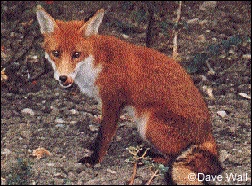
![]()
![]()

![]()
![]()
21st Century Mammal
There may be tough times ahead for many of the world's species but as Dave Wall of UCD's Mammal Research Group reports, the flexible fox is more than prepared for the impending future.
The 20th Century has been marked by the destruction of wildlife habitats worldwide and the extinction of thousands of species.
As we stumble into the next millennium an uncertain future awaits many animals and plants, faced with extinction due to the pressures of human population expansion and industrial activities.
However, not every species has the cloud of doom hanging over its head. Some have managed to survive, while others... well, others have downright thrived.
The red fox is a shining example of this. At first glance, all the odds seem stacked against it. It is a mammal of medium size and is heavily persecuted. Hunted for its fur, it is also chased, shot, poisoned, snared and trapped by the thousand as an "agricultural pest", and chased and hunted for sport.

|
| One of Dublin's urban foxes licks its lips in satisfaction after securing a free meal in Donnybrook. |
Despite all this, red fox numbers show no sign of decreasing and the species successfully occupies habitats right across the Northern Hemisphere and Australia.
The adaptive traits which have made the red fox so successful are clearly displayed in the urban fox. Red foxes have occupied our cities and towns for many years now.
In England, where the urban fox phenomenon is most common, there are reports of city-dwelling foxes going back to Victorian times. However, it is only after the post-war housing boom that the urban fox really flourished.
On the other side of the Irish sea, Dublin also has a healthy population of urban foxes. A survey of South Dublin in 1995 showed foxes to be present right across the city and suburbs in densities comparable to those of many British cities.
Although classified as a carnivore, the red fox is truly an opportunistic omnivore. It can utilise whatever food sources are available and alter its diet to avail of whatever food is most abundant at the time.
Dublin's foxes live on a diet consisting largely of invertebrates, which they hoover up from the lawns and flower beds of our parks and gardens. These they supplement with whatever small mammals and birds they can catch, as well as berries and other fruits. Most also have a regular banquet provided for them by some of the city's foxwatchers.
Urban foxes suffer a very high mortality rate and, consequently, the majority of the population in any one year consists of animals in their first or second year. Despite the heavy toll, the reproductive success of the fox is able to match and outstrip the death rate.
Their adaptability has made them one of the 20th Century's mammal success stories and they are well positioned to thrive far into the next millennium....truly a 21st century mammal.
This article was first published in The Badger, No 71, Spring 1999. Our thanks to both the Irish Wildlife Trust and Dave Wall for granting us permission to reproduce it here.
![]()
![]()